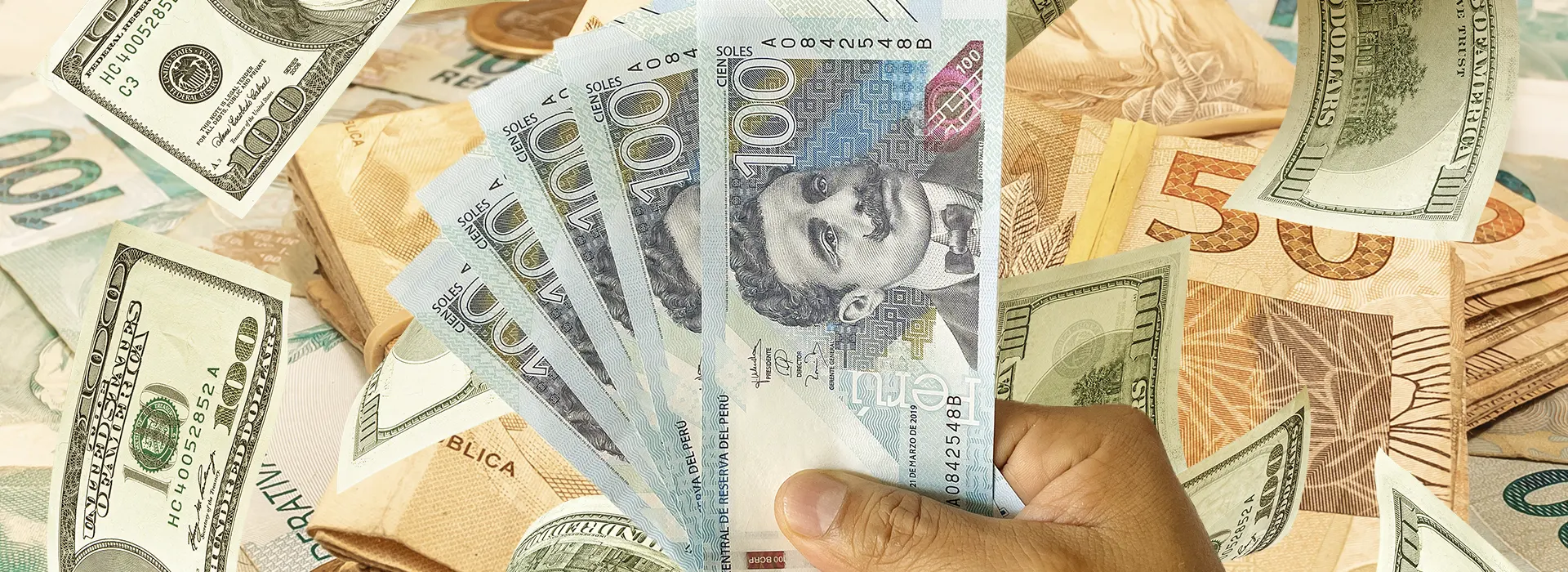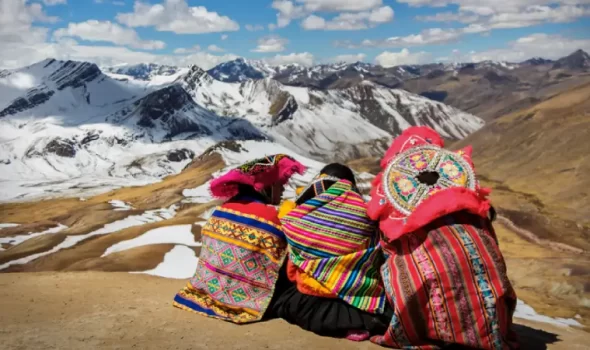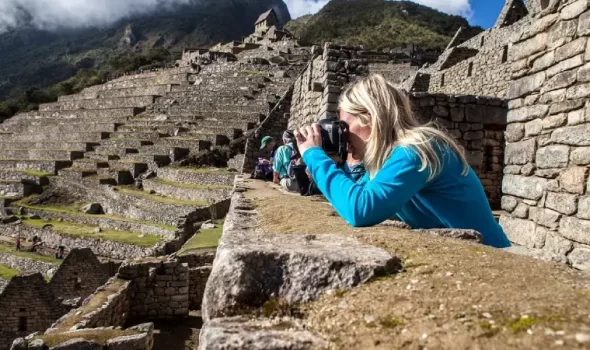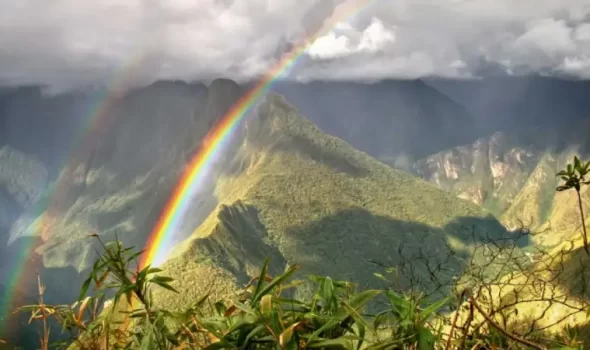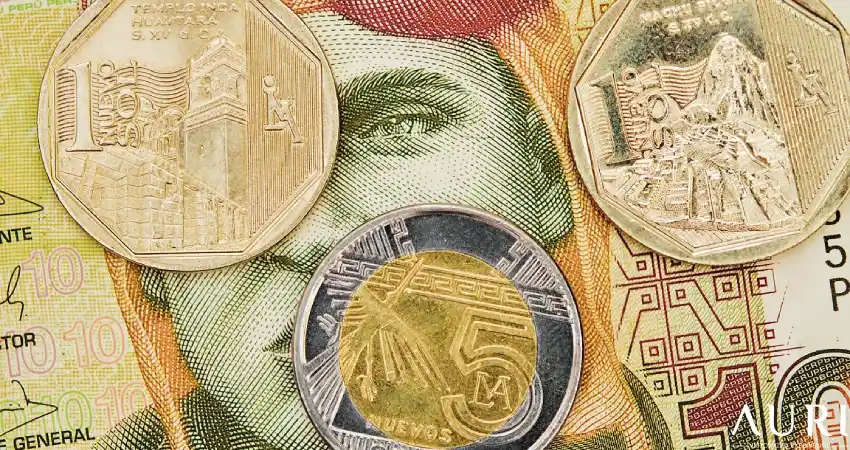
Peruvian 1 sol and 5 soles coins
1.- The Peruvian currency is the Nuevo Sol (S/).
As the official currency of Peru, the Nuevo Sol (S/) is divided into 100 cents. Coins are available in denominations of 5, 10, 20, and 50 cents, while bills are available in denominations of 10, 20, 50, 100, and 200 Nuevos Soles. In Peru, ATMs are widely available and accept most international credit cards. The Nuevo Sol is a relatively stable currency and can be exchanged for other major world currencies.
ATMs are widely available throughout the country. For convenience, it is recommended to have a mix of cash and a credit or debit card while traveling in Peru, as the Nuevo Sol is widely accepted in many places and ATMs are plentiful.
2.- Exchange rate
Several studies have shown that Peru’s currency is strengthening as a result of responsible economic policies. The exchange rate is approximately 3.50 to 4 Nuevos Soles per $1, meaning $100 is worth approximately S/350 to S/400. The exchange rate has remained relatively stable over the past decade. Since Peru is a country where exchange rates fluctuate constantly due to supply and demand, foreign investors are able to conduct business and attract new investments more easily. Furthermore, Peru has improved its ability to trade with other countries, as well as its citizens’ ability to travel abroad.
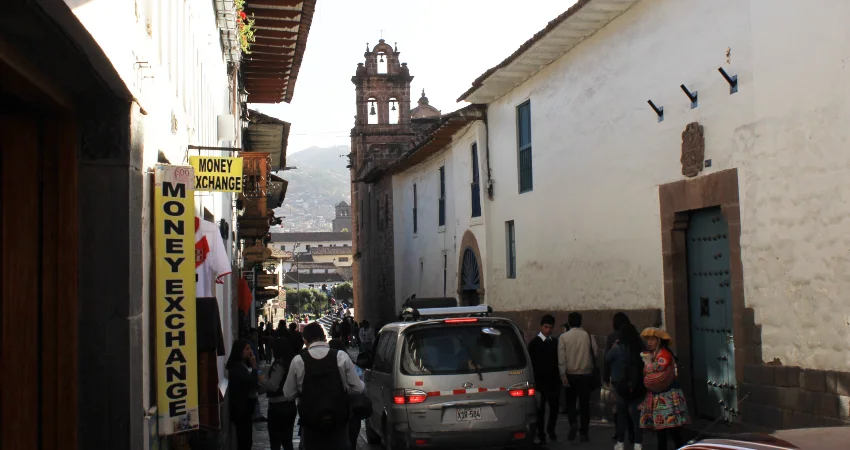
Money exchange near Cusco main square.
3.- Where to exchange money in Peru
In Peru, it is recommended to exchange your money at an exchange house. These houses are generally located in tourist areas. Do not exchange on the street; instead, visit an exchange house. Major currencies, such as the US Dollar and Euro, are commonly accepted, whereas the British pound may not be as popular. However, be sure to compare the exchange rates between different exchange houses to find the best deal. You should also keep in mind that some exchange houses charge commissions or fees.
Ensure that you are aware of all hidden costs associated with an exchange before making a transaction. Always keep your receipts in case you need to prove the exchange.
4.- Paying with credit cards
A wide variety of credit cards are widely accepted in Peru, and American Express is also widely accepted in some places. In many places, there is a wide range of credit cards that are widely accepted, but smaller shops prefer cash. Be sure to bring your ID and PIN with you when traveling.
A cash payment can sometimes be more advantageous than a credit card in certain situations. When choosing a credit card, it’s crucial to check the terms and conditions and be aware of any foreign transaction fees that may apply. Credit cards often have higher fees, so it’s important to do your research beforehand.
5.- Peru’s ATMs
It is common to find ATMs (“Cajeros Automáticos”) throughout Peruvian cities, which are capable of dispensing both Soles and USD. ATMs are reliable, easy to operate, and are connected to the international banking network. There is usually a small fee for each transaction, and some ATMs are only available to customers of certain banks. Before withdrawing money in Peru, it is essential to check the limits of each ATM.
BCP, Scotiabank, BBVA Continental, and Interbank are just a few of the major banks that operate in Peru. However, transaction fees should be taken into consideration. Whenever possible, it is preferable to utilize ATMs located in secure areas rather than street-based ATMs. Keeping your bank informed of any additional charges for international withdrawals is important. To avoid any inconvenience, it is a good idea to notify your bank prior to traveling abroad. Furthermore, your card and PIN should always be kept secure.
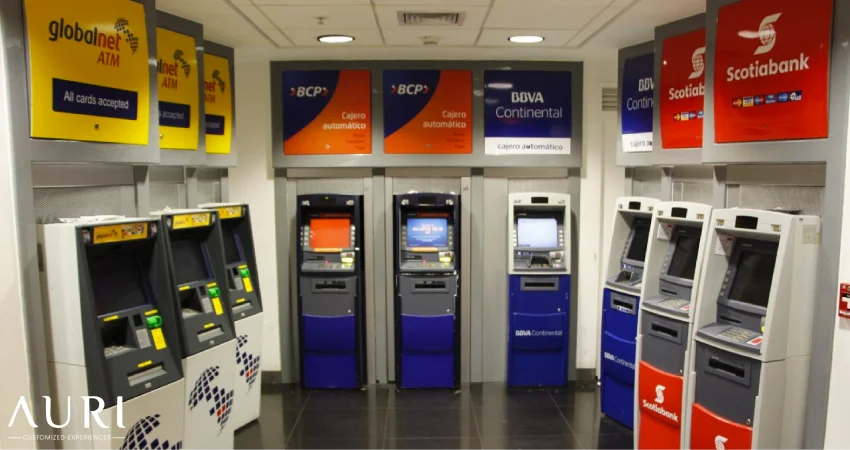
ATM in Peru
6.- Peru on a budget
Peru is renowned for its affordability, and there are plenty of budget-friendly options for those who want to save. For those looking for comfort and luxury, there are plenty of options too. Peru is well-connected, with plenty of flights and train routes, and it’s a safe destination for travelers.
Various budgets are accommodated in Peru. For budget travelers, $50 per day is doable, while more comfortable options range from $70 to $100. Luxury travelers can spend upwards of $500 per day. Even luxurious trips to Machu Picchu are accessible, and Peru’s currencies include the US dollar, euro, and pound. Peru has something for everyone. From affordable to luxury travel, it is possible to find the perfect experience for any budget. Tourist attractions, modern amenities, and stunning landscapes make Peru a great destination.
7.- Giving tips
While tipping is not a tradition in Peru, it is considered as a way to express appreciation for good service. Therefore, leaving a small tip of 10% above the cost of the service is seen as a sign of respect and goodwill. Additionally, when locals are satisfied with the quality of service they have received, it is common for them to leave more generous tips of 20%. Although not expected, tipping is considered a sign of appreciation. Also, it is regarded as a way to demonstrate the customer’s appreciation for the service provided.
Additionally, it is a way for tourists to express their appreciation and appreciation for the service provided to them. Therefore, a 10% to 15% tip is standard for tourists in Peru.
8.- Peruvian cost of living
Despite the increasing costs of tourism in Peru, it remains affordable for tourists from North America and Europe. Peru ranks 110th compared to 8th for the United States on the list of the most expensive countries in the world. Machu Picchu remains accessible with a variety of budget-friendly accommodations available.
However, the cost of living in Peru remains low compared to other countries, making it an ideal destination for travelers on a budget. Peru’s diverse landscape and rich culture make it an ideal place to explore. There are about 1.2 million visitors annually to Machu Picchu. It’s like finding a diamond in the rough; despite the rising cost of travel, Peru remains a great value, offering travelers on a budget an excellent value.
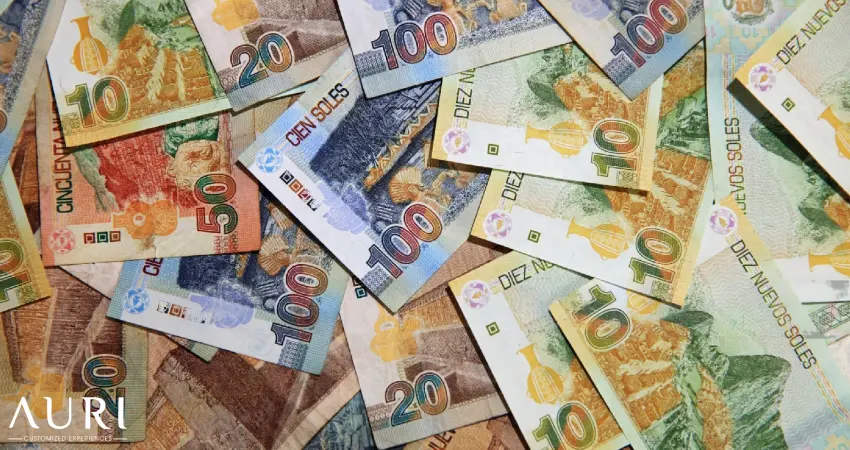
Peru bills
9.- Price negotiation
A common practice in Peru is bargaining, especially for goods and services that do not have a fixed price. When negotiating prices, it is important to be respectful and to agree on a final price before the transaction is complete. This will help to avoid any misunderstandings or disappointments. It has been shown that Peruvians respect those who are polite and direct. It is also appreciated when people know their own value and don’t hesitate to ask for what they deserve. Bargaining is seen as a sign of respect for both parties and ultimately ensures that everyone is satisfied with the final result.
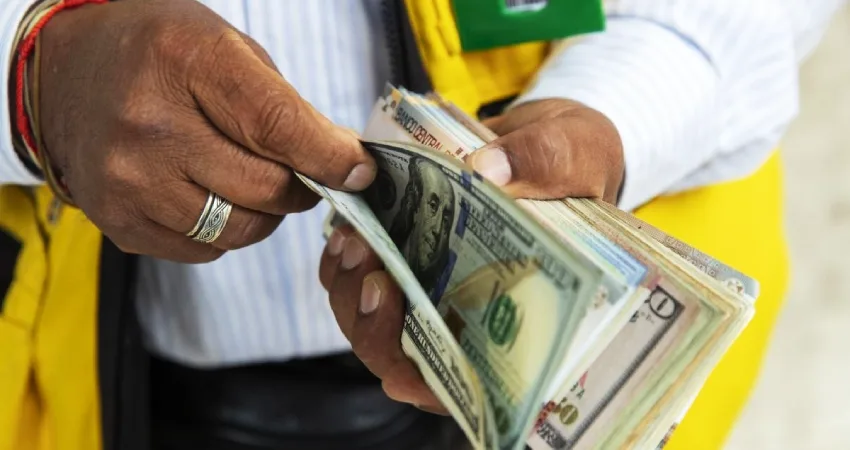
Be sure to exchange your currency for Peruvian currency as soon as possible
10.- Badly damaged money in Peru
Neither Peruvian Soles nor US dollars in poor condition are acceptable. The Peruvian currency should not be torn, written-on, or excessively worn. If you wish to use American money, please ensure that it is in good condition. Coins should be free of dirt and debris. Additionally, bills must not be wrinkled, torn, or marked. For example, a bill that has been taped together or has a large tear may not be accepted.
The National Bank of Peru accepts foreign banknotes for exchange. Banknotes should be in excellent condition and should not be damaged in any way.
At the branches of the Central Reserve Bank of Peru, you can avail the service of exchanging legitimate, intact banknotes that might have incurred damage. To ensure the authenticity of the banknotes submitted for exchange, it’s imperative that they possess key security features, such as watermarks and color-changing ink. Additionally, the presence of security threads on the banknotes is equally important. It’s important to note that the exchange of counterfeit banknotes is strictly prohibited across all branches of the Central Reserve Bank of Peru.
11.- Peruvian counterfeit money
There is a problem of counterfeit money in Peru, which is why it is important to examine bills and coins for watermarks and other security features to determine their authenticity. Exchange suspicious currency if in doubt. Make sure that large amounts of cash are not counterfeit. For large amounts of cash, it is best to use a trustworthy money exchange service or bank. Request a receipt for all cash transactions.
Don’t forget to be aware of your surroundings when handling or exchanging money in Peru. Do not accept money if you have any doubts about its authenticity. Do not accept counterfeit money. And don’t forget to keep an eye out for suspicious-looking llamas!
12.- Here are some tips and interesting information about peruvian money when you arrive to Peru
-
Make sure to bring cash or use a debit/credit card to withdraw money from ATMs. Exchange rates and fees may vary, so make sure to research before traveling. Keep your receipts, as some stores may require them.
-
When you arrive in Peru, be sure to exchange your currency for Peruvian currency as soon as possible. In addition, it is important to become familiar with the denominations of Peruvian bills and coins. Be aware of the current exchange rate and only exchange money at authorized banks or currency exchange offices.
-
In order to prevent counterfeiting, watermarks are used. Watermarks are unique patterns or images that are embedded in paper or other materials. They are typically only visible at an angle and are difficult to reproduce. This makes them an effective method of preventing counterfeiting.
-
There are strategies for finding budget-friendly accommodations and experiences when traveling to Peru during the peak tourist season (April to October). Approximately $1,361 is the average cost of a week-long budget trip to Peru for an individual traveler, $2,444 is the average cost for a couple, and $4,582 is the average cost of a family of four.
-
The practice of haggling is established in Peru, but one must be patient and familiarize himself with the local customs as well as the current exchange rate to ensure that transactions are fair.
-
It is prudent to carry duplicate copies of crucial documents and credit cards. Vigilance against pickpocketing is imperative, as well as protecting belongings. Lastly, maintaining a courteous and amiable demeanor with vendors is highly recommended. If the prices seem exorbitant, it is perfectly acceptable to politely decline and explore other options.}
Prior to exchanging currency in any Peruvian city, it’s advisable to cross-check the current exchange rates. Always request a receipt and meticulously verify the accuracy of the exchange rate. Under no circumstances should counterfeit currency be accepted. It is also important to consult with locals to determine which shopping places have the best prices and to find out what you should be looking for.
Additionally, it is important to check reviews and ratings of the products or services before making a purchase. You should also compare prices in different shops to ensure you get the best deal. By incorporating these guidelines into your travel journey, you will be able to adeptly manage currency-related issues, and enjoy it fully. But most importantly, don’t forget to have fun! After all, travelling is a journey, not a race!
Remember, financial issues in Peru are a constant consideration. Auri Peru Travel has a team of professionals on staff that can assist you if you have any concerns




